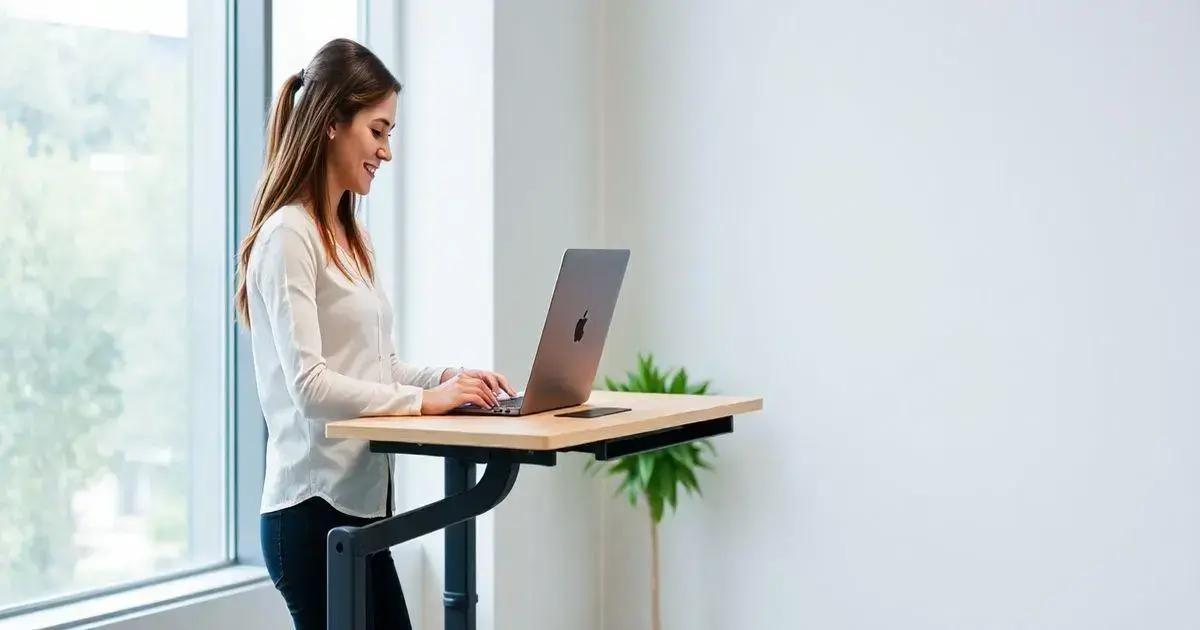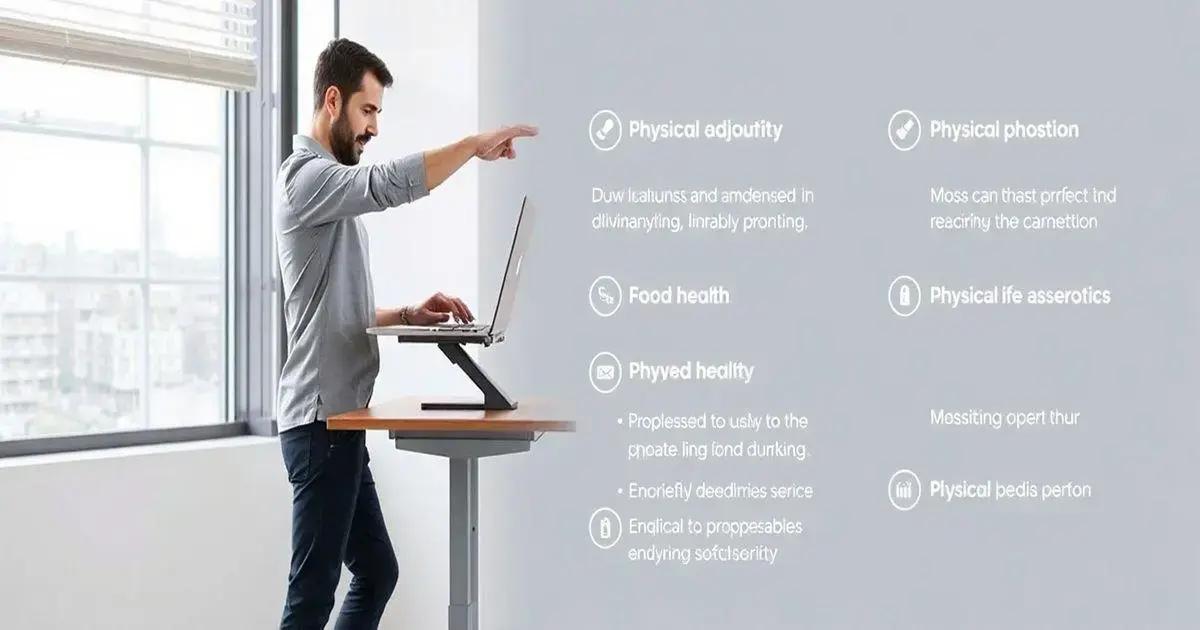The impact of standing desks on men’s physical and mental health can be significant, offering benefits like reduced risk of chronic illnesses, improved posture, boosted energy levels, and enhanced mood. By integrating standing desks into the workplace through gradual adjustment, proper desk height, and the use of anti-fatigue mats, individuals can enjoy a healthier and more productive work environment.
The impact of standing desks on men’s physical and mental health is gaining attention in today’s work environment. With more individuals transitioning to hybrid work models, understanding how standing desks can enhance well-being is essential. In this article, we’ll explore the key benefits associated with standing desks, including improvements in physical health, such as injury prevention, and mental health aspects like increased focus and reduced stress levels. Discover actionable tips for incorporating standing desks into your routine effectively.
Understanding Standing Desks: An Overview

Standing desks have become increasingly popular in modern workplaces, promoting a healthier alternative to traditional seated office setups. They allow individuals to alternate between sitting and standing, providing flexibility throughout the workday. This shift in posture can have significant effects on both physical and mental well-being.
What is a Standing Desk?
A standing desk is any desk that allows the user to work while standing up comfortably. They come in various styles, including adjustable models that let you switch between sitting and standing positions at any time. This versatility makes them ideal for maintaining comfort and energy levels.
The Purpose and Benefits of Using Standing Desks
The primary purpose of standing desks is to reduce the health risks associated with prolonged sitting. Many health experts suggest that excessive sitting can lead to various health issues, such as obesity, cardiovascular disease, and musculoskeletal disorders. By using standing desks, individuals can promote better posture and increase their activity levels during work hours.
Design and Features
Standing desks come equipped with various features that enhance usability. Some desks have robust, electric lift systems that allow you to raise and lower the desk with just the press of a button. Others feature simple, manual adjustments. Many come with additional accessories, such as ergonomic mats and monitor stands, to ensure optimal comfort and alignment.
Ergonomic Considerations
When using a standing desk, it’s crucial to maintain proper ergonomics. This includes ensuring the computer screen is at eye level and your wrists are straight while typing. Additionally, it’s recommended to shift your weight from one foot to another or use a footrest to reduce fatigue. Understanding these factors can significantly enhance your experience and health benefits from standing desks.
Physical Health Benefits of Standing Desks

There are numerous physical health benefits of standing desks that contribute to overall well-being. One of the most significant advantages is reducing the risk of weight gain. Studies suggest that individuals who stand more during the day burn more calories than those who remain seated for extended periods.
Decrease in Chronic Health Conditions
Using standing desks can lower the risk of several chronic health conditions. It helps reduce the chances of developing cardiovascular diseases and diabetes by promoting better circulation and maintaining healthy blood sugar levels.
Improved Posture
Another benefit is improved posture. Standing encourages better spinal alignment, which can help mitigate issues like back, shoulder, and neck pain that are common in sedentary workers. Proper alignment can enhance comfort levels and productivity.
Enhanced Energy Levels
Many users report feeling more energized when working at standing desks. This boost in energy can lead to increased motivation and focus throughout the day. Higher energy can also foster greater physical activity at work, reducing fatigue that often accompanies prolonged sitting.
Lower Risk of Musculoskeletal Disorders
By alternating between sitting and standing, individuals can reduce the risk of musculoskeletal disorders. These disorders can arise from repetitive movements and poor posture associated with sitting for too long. Standing desks encourage natural movement and flexibility, helping to alleviate discomfort and strain.
Mental Health Improvement from Adjustable Desks

Adjustable desks not only enhance physical health but also provide notable mental health improvements. Users of these desks report feeling more focused and productive during their workdays. Being able to change positions helps maintain energy levels and reduces the mental fatigue often caused by sitting for long periods.
Reduction in Stress Levels
Standing desks can significantly lower stress levels. When people can move freely while working, they often experience less anxiety and discomfort. Flexibility in workspace arrangements allows individuals to find their optimal work position, enhancing their comfort and reducing stress.
Boosted Mood
Using an adjustable desk can lead to a better mood and overall psychological well-being. The act of standing rather than sitting can create a feeling of empowerment and control over one’s environment. Many users have reported feeling more positive and engaged with their tasks.
Increased Motivation
Adjustable desks can encourage a more dynamic workflow. By allowing employees to alternate their working position, they can break the monotony of a fixed setup. This variation boosts motivation, keeps individuals interested in their tasks, and promotes creativity.
Enhanced Collaboration
Adjustable desks can also facilitate better collaboration among team members. When workstations are designed to allow movement and standing, it can encourage more teamwork and interaction. A more social work environment plays an essential role in reducing feelings of isolation and enhancing workplace camaraderie.
Practical Tips for Integrating Standing Desks

Integrating standing desks into your workspace can be an easy transition when you follow some practical tips. These guidelines can help maximize benefits while ensuring comfort and efficiency.
Start Gradually
Begin by using your standing desk for short periods. Aim for around 30 minutes of standing and then switch to sitting. Gradually increase your standing time as you adjust. This gradual shift helps your body adapt and reduces any initial fatigue.
Proper Desk Height
Ensure that your desk is at the correct height. Your elbows should be at a 90-degree angle when typing, and your monitor should be at eye level. This helps maintain good posture and prevents discomfort.
Invest in an Anti-Fatigue Mat
Using an anti-fatigue mat can greatly improve comfort while standing. These mats provide cushioning for your feet, reducing discomfort from standing for long periods. This simple addition encourages you to stand longer without fatigue.
Keep Moving
While using a standing desk, remember to move around. Shift your weight from one foot to the other and take short breaks to walk around. Incorporate stretches or light exercises during breaks to promote circulation and enhance overall comfort.
Personalize Your Space
Make your workstation inviting. Add personal touches like plants or inspirational quotes. A well-organized desk can boost productivity and help create a positive work environment. Consider using a footrest to shift your weight and create variation in your stance.
In Summary: The Benefits of Standing Desks
The impact of standing desks on men’s physical and mental health is profound. Incorporating standing desks into the workplace can lead to significant improvements in both health aspects.
From reduced risks of chronic illnesses to boosted energy levels and better moods, the advantages are compelling. Additionally, practical integration tips make it easier to adapt to this healthier work style.
Ultimately, standing desks not only enhance productivity but also promote a more active and balanced lifestyle. Embracing these changes can pave the way for healthier work environments and improve overall well-being.
FAQ – Frequently Asked Questions About Standing Desks and Their Impact
What are the main benefits of using standing desks?
Using standing desks can lead to improved physical health by reducing the risk of chronic illnesses and promoting better posture. They also enhance mental health by boosting energy levels and improving mood.
How can I gradually transition to using a standing desk?
Start by using the standing desk for short periods—around 30 minutes—and gradually increase the standing time as your body adapts.
What is the correct height for my standing desk?
Your desk should be at a height where your elbows are at a 90-degree angle while typing, and your monitor is at eye level to maintain good posture.
How does using an anti-fatigue mat help?
An anti-fatigue mat provides cushioning for your feet, helping to reduce discomfort and fatigue from standing for long periods, which encourages longer standing times.
Why is movement important when using a standing desk?
Keeping active while using a standing desk is essential for promoting circulation and preventing fatigue. Regular movement helps maintain energy levels.
Can adjustable desks improve workplace collaboration?
Yes, adjustable desks facilitate a more dynamic work environment, encouraging interaction and collaboration among coworkers, which can reduce feelings of isolation.












